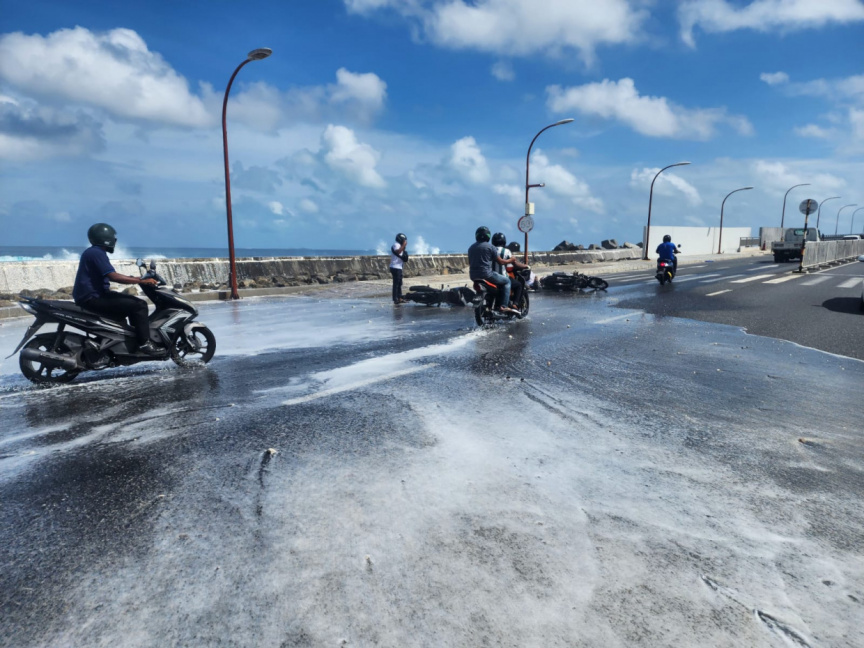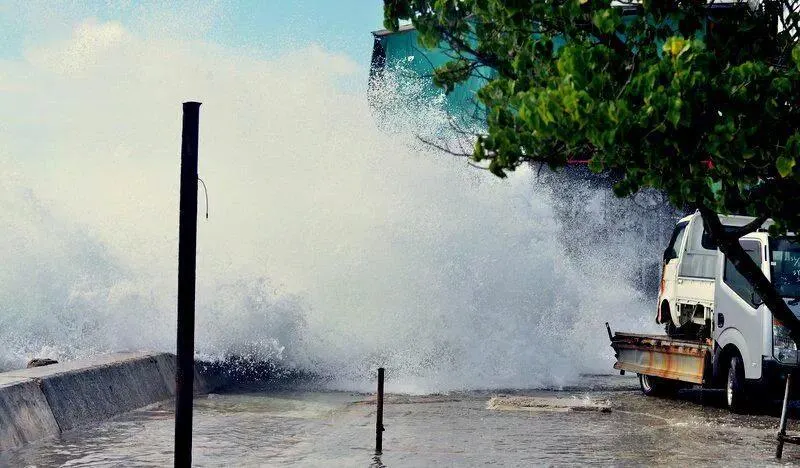What Are Swell Waves?
Swell waves are long and powerful ocean waves generated by distant storms or strong winds far from the Maldives. Unlike local wind waves, swell waves can travel thousands of kilometers across the ocean and reach the islands even when the local weather is calm. These waves often appear smooth and rolling but can carry significant energy, resulting in coastal flooding and erosion.
In the Maldives, swell waves are most common during the southwest monsoon season (May to October). They are often caused by deep low-pressure systems and cyclones in the southern Indian Ocean or the Arabian Sea that send long wave trains toward the islands.

Swell waves flooding affects the Sinamale' Bridge on August 5, 2023. (Photo Sun Mv)
Causes of Swell Waves
Swell waves are mainly generated by:
Distant Storm Systems: Strong winds associated with cyclones or depressions over the southern Indian Ocean.
Persistent Wind Fields: Long-lasting wind patterns across open ocean areas build up large swells.
Monsoonal Winds: Southwest monsoon winds push swell energy toward Maldivian atolls.
Tidal Influence: When swell waves coincide with spring or king tides, they can cause more extensive coastal flooding.

A king tide, caused by the coinciding of a full moon and bad weather causes flooding across the Maldives on September 28-29, 2015 (Photo Maldives Independent)
Risks and Impacts
Although not caused by local storms, swell waves can lead to:
Coastal Flooding and Erosion: Overtopping of sea walls, beach erosion, and saltwater intrusion.
Infrastructure Damage: Impacts to harbors, coastal roads, and resort facilities.
Disruption of Transport: Strong surges can make sea travel unsafe, especially for small vessels.
Loss of Freshwater Sources: Saltwater intrusion contaminates groundwater on low-lying islands.
Past swell events have caused severe flooding in southern and western islands, particularly during high tide conditions, damaging homes and disrupting livelihoods.
Swell Waves Alerts and Warnings
Because the Maldives lies close to the equator, most disturbances that form nearby do not develop into full tropical cyclones due to the weak Coriolis effect. However, the effects of these systems such as rainbands, gusty winds, and storm surges—can still cause widespread disruption across the islands.
Before a Swell Wave
Follow weather updates from MMS and NDMA.
Move vehicles, boats, and movable property to higher ground.
Strengthen temporary barriers (sandbags, boards) along low-lying areas.
Avoid coastal construction or maintenance during swell alerts.
Inform fishermen and resort staff of possible sea and coastal hazards.
During a Swell Wave
Keep away from shorelines and flooded areas.
Do not drive or walk through coastal floodwaters.
Avoid sea travel unless absolutely necessary.
Secure boats, fishing gear, and equipment away from the shore.
Stay tuned to official announcements for updates.
After a Swell Wave
Inspect homes and coastal structures for damage.
Report flooding, erosion, or saltwater intrusion to local authorities.
Avoid contaminated water and floating debris.
Participate in community cleanup only after conditions are declared safe.
Stay Prepared, Stay Safe
Swell waves can arrive suddenly and with great force, even on calm days. Early awareness, timely alerts, and local preparedness help protect lives and livelihoods in island communities.